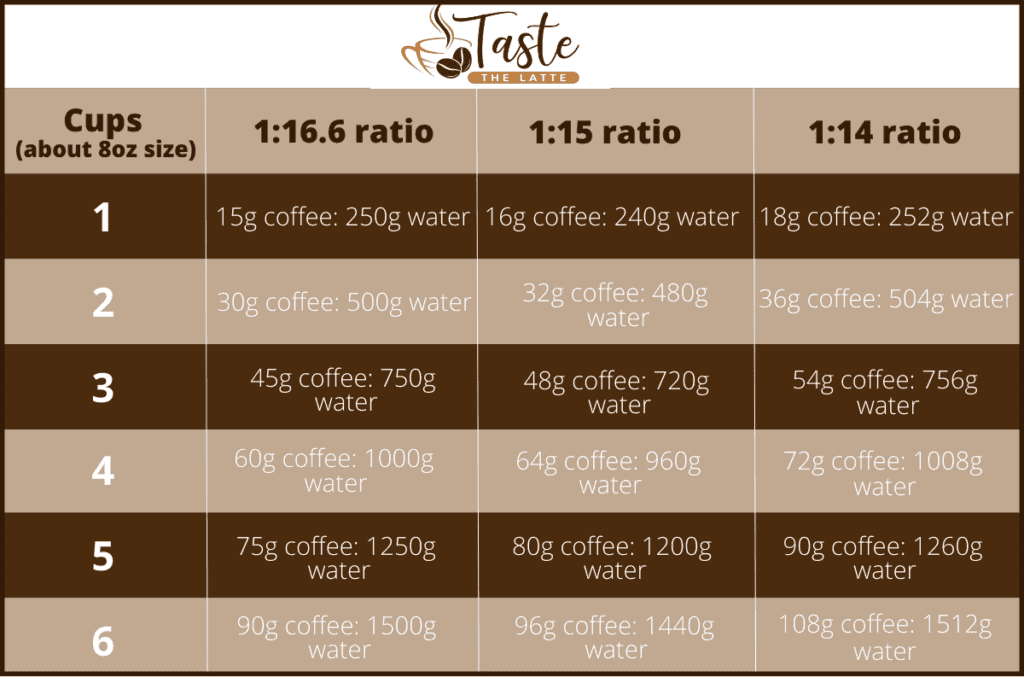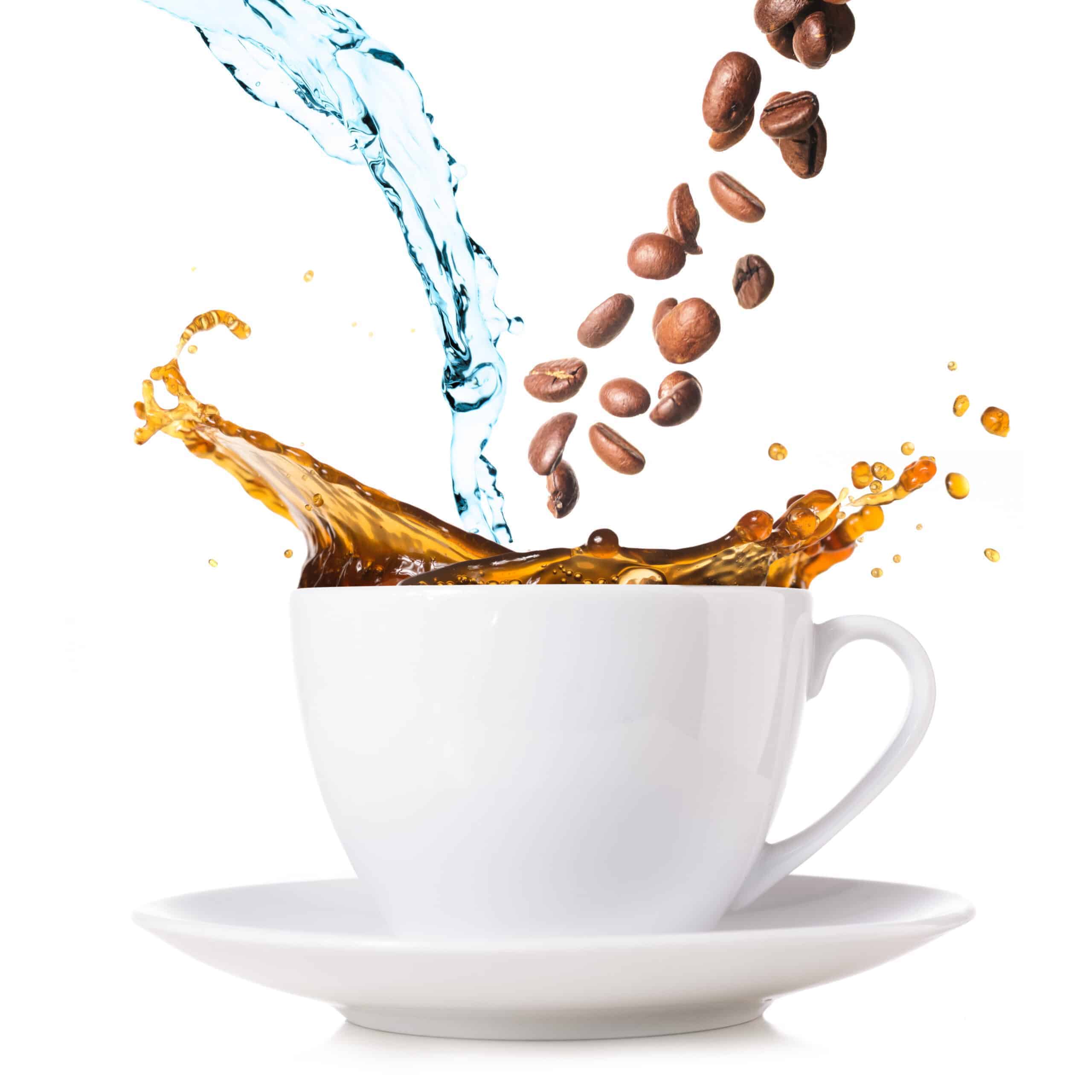When making great coffee, many people use a ratio to work out how much coffee and water they need to make their coffee. Using a ratio is a great way to make a consistent tasting coffee. Whether you’re making a coffee for yourself or a group of people, you can easily work out how much coffee and water you will need.
What is the best coffee-to-water ratio? The best coffee-to-water ratio depends on your personal preference and the kind of coffee you are making. Typically, you would want to start with 1:15, one part coffee grounds to 15 parts water. For espresso the ratio is 1:2.
The best thing to do with a coffee ratio is to establish a starting point ratio that you know you like, and then if your coffee doesn’t taste as good as you think it could, slightly adjust it.
Here are starting points.
Filter Coffee (French Press/V60/AeroPress/Clever Dripper/Chemex).
1 :15 // 1 cup = 16g coffee to 240g water
Espresso (Espresso Machine, Stovetop, Cafflano)
1:2 // 1 double espresso = 18g coffee to 36g water
Why use ratios? Ratios are scalable and repeatable. Why use grams and not scoops and cups? Scoops and cups are not very accurate. You can’t identically repeat them over and over again and continually make a perfect coffee.
Filter Coffee Ratios
Filter coffee makers such as pour-overs and drip coffee machines are going to use a different ratio than espresso.
I always start with a 1:15 water to coffee ratio for two reasons. First, it is usually fairly accurate for my preference. Not so strong that I do not enjoy the coffee and not so mild that I do not get the flavors through in my coffee. The second reason I start here is that the math is dead easy!
The most common recipe I come across for filter is a two-cup recipe of 30 grams of coffee to 500 grams of water. This is a 1:16.6 ratio, which is a little more difficult on the maths front if you find you have 17g of coffee and want to use it all. I also find 1:16.6 a bit lacking in flavor.
However, to save you on the math and give you some strength options, below is a table of ratios. The middle column is 1:15 ratio, the left column is a 1:16.6 ratio, and the right is a 1:14 ratio for those who prefer a more robust cup of filter coffee.

If you are brewing with an AeroPress, you will only be able to make one cup of coffee at a time/ For a V60, or clever dripper, you’re probably going to be limited to two cups due to their size. However, with a large French Press or Chemex, if you can easily fit your total amount of water in it, you should be able to brew up to 6 cups.
Espresso Ratios
The established ratio for espresso is a little easier, 1:2. But, making a perfectly balanced espresso is quite tricky. The best way to start here is to see how much coffee the basket in your espresso machine handle will hold.
With a small home espresso machine, this is likely to be around 15g, but with a more substantial or commercial espresso machine, you may have a basket that holds up to 20g. If your basket does hold 15g, when you run the espresso, put a set of scales under the cup catching the espresso, and just before it reaches 30g, stop the water flow (if you stop at 30g by the time you have pressed the button you will have more than 30g in the cup).
As long as the espresso pulls in between 28 and 32 seconds, you should make a pretty tasty coffee. If you feel it’s too strong or mild, adjust either the amount of coffee or water (not both at the same time) to taste.
When doing this, also consider that both these changes will change the extraction time of your espresso, so you will need to also adjust the size of the grind on your coffee grinder (for example if you add more coffee to your basket, it will slow down the flow of water through it, so you will need to grind slightly coarser to counteract that).
Once you have found a good starting point ratio, you are on to a winner. No matter how much coffee you have or want to make, you know you can make something delicious. However, always remember every coffee is slightly different, so be prepared (especially with espresso) to make minor adjustments.
Every water is also different. For example, depending on where you live, the water may be of better/lesser quality. While some tap water tends to be very soft other tap water is very hard making the coffee taste different. Weird right?
If you do not believe me (totally understandable), try putting your tap water through a Britta filter before brewing, or try using some bottled water. You might find when you compare it to your coffee made with tap water; it tastes quite different.
What if the Coffee is Too Strong?
Once you’ve tried a specific ratio and tasted it, you can adjust it to your liking. If you tried a coffee-to-water ratio of 1:17 and it tastes too strong, then the next time, try 1 part coffee to 16 parts water.
The less coffee you use, the less strong your cup of coffee will be. Or, you can increase how much water you are using.
What if the Coffee is Too Weak?
On the other hand, if you’ve tried a particular ratio and thought the coffee tasted too watered down, then use more coffee or less water the next time you brew. It’s really that simple.
You can adjust as many times as needed to find that perfect ratio, or golden ratio, for you.
Importance of Coffee Scales
If you are new to this whole measuring coffee thing and ratios, understanding the importance of investing in a good coffee scale is crucial. Scales allow you to use a coffee-to-water ratio with precision and consistency.
Some scales are better than others. When measuring ground coffee, buying a scale that measures in grams rather than ounces, oz is always best. Because you only use a small portion of ground coffee at home for a single cup or up to 8 cups, a scale that measures in grams will be more accurate.
Digital scales are also a life-saver when it comes to reading scales. Finally, it’s beneficial to purchase a coffee scale that is small and compact. Whether you store it on your counter or cupboard, no one wants a bulky scale hogging up space.
To read more about coffee scales and see our top picks, click here.
Other Factors that Affect Coffee Taste
Using a water-to-coffee ratio is only one factor that goes into making a consistently great cup of coffee. There are a handful of others to be aware of.
- Quality of your coffee beans
- Using fresh whole beans
- Using a burr coffee grinder and only grind what you need.
- Using appropriate grind size for brew method (fine grind, medium grind, coarse grind)
- Brewing with water temperature that is between 195 and 205 degrees F.
- Ensuring your coffee equipment is clean and descaled.
